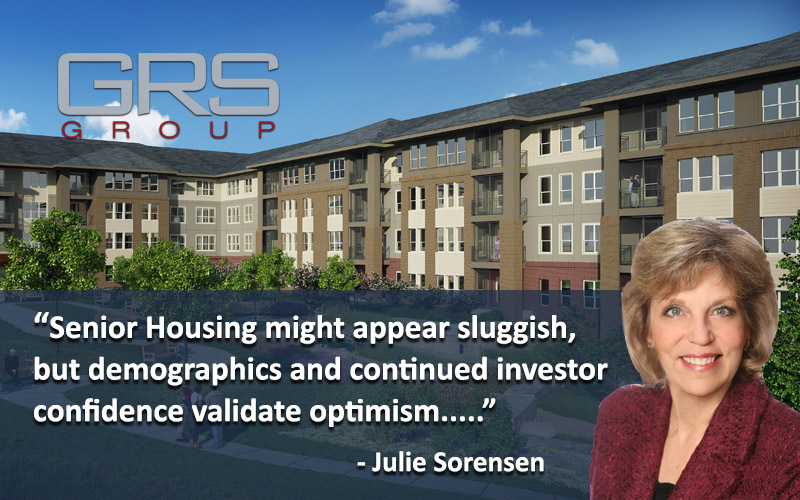
Julie Sorensen
Director, GRS | Corteq
(312) 476-7658
[email protected]
The seniors housing sector of commercial real estate might currently be experiencing some sluggish fundamental numbers, but demographic numbers and continued investor confidence should ensure its future health.
A recent Seniors Housing Investor Outlook webinar hosted by National Real Estate Investor and NIC (National Investment Center for Seniors Housing & Care), went over several key statistics that illustrate how the sector should perform more than a decade out.
Much of the data presented by NIC speakers was based on a seniors housing investor survey the organization conducted with NREI throughout May and June.
The data garnered showed some investor trepidation compared to 2017’s survey. For example, 27 percent of those polled said that there is overbuilding in the sector compared to just 20 percent last year, and 69 percent said new product will negatively impact vacancy, up from 59 percent over 2017.
Meanwhile, occupancy rates were at 87.9 percent during the second quarter, down 80 basis points from the same year-ago period, marking the 10th-straight quarter of occupancy declines.
Despite that, those taking the survey view seniors housing the most attractive commercial real estate property sector in which to invest, and overwhelmingly more expect to buy than sell this property type. Since the executives polled were in seniors housing, additional surveys from ULI/PwC and Institutional Real Estate (IREI) mainly back it up. The ULI/PwC study said seniors housing ranked third overall over 24 property types for investment and development and at the top of all residential from a buying perspective and the lowest for selling. IREI ranked seniors housing fourth of 15 types of assets among domestic investors and second for foreign investors.
There are some strong reasons for this.
The sector has a total market value of $409 billion and it’s experiencing increased transparency, which has brought in more liquidity, and many investors now consider it a core asset class. And those who hold their senior housing properties for five to 10 years are experiencing higher returns than any other sector.
“These days an investor coming into the purchasing of seniors housing property knows that there’s an exit plan they can use to be able to sell that property as time goes on,” pointed out Beth Burnham Mace, chief economist and director of outreach at NIC.
This has diversified the buyer pool for these assets. Once dominated by REITs, now institutional and private money is more prevalent in the sector.
Most importantly, demographic numbers are in its favor. This year, only about one percent of the U.S. population is 75 or older. By 2030, that number is expected to shoot up to around 10 percent. Additionally, due to lower fertility rates by the Baby Boomer generation than its predecessor, there will be fewer family members to care for their aging parents, making assisted living and other facilities more of a necessity.
“Although we don’t see the wave of Baby Boomers coming in and we won’t for another decade, as a generation, [they’re] very much focused on well-being, and I think we’re just now at the cusp of more research coming out speaking to the advantages of living in a communal setting, which can bolster that well-being”, said Chuck Harry, chief of research and analytics at NIC.
About GRS Group:
GRS Group is a leading provider of commercial real estate (“CRE”) services worldwide. With offices across the United States, Europe, and affiliates around the globe, GRS Group provides local market knowledge with a global perspective for institutional real estate investors, occupiers and lenders worldwide. The GRS Group team has evaluated and advised on over $1 trillion in CRE transactions.

